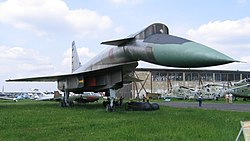Sukhoi T-4
| Sukhoi T-4 Sotka | |
|---|---|
 Sukhoi T-4 "Sotka" in Monino |
|
| Type: | Prototype of a strategic bomber |
| Design country: | |
| Manufacturer: | |
| First flight: |
22nd August 1972 |
| Commissioning: |
- |
| Production time: |
- |
| Number of pieces: |
4th |
The Sukhoi T-4 Sotka ( Russian Сухой Т-4 Сотка , German hundreds ) was a Soviet project of a supersonic long-range bomber from the time of the Cold War . The official type designation is T-4, occasionally it is also incorrectly referred to as Su-100.
history
The history of its origins goes back to the government tender for an aircraft to effectively combat enemy aircraft carriers in the autumn of 1961, which was addressed to the Tupolev , Yakovlev and Sukhoi design offices , although the latter had no experience in building jet-powered large bombers. Yakovlev's design was rejected and Tupolev's design 136 became the Tu-22M . Sukhoi's design was worked out by its chief designer, Chernyakov. The aircraft should reach a maximum speed of Mach 3, have a range of 3000 km and fight ships with two missiles with a range of 600 km and a payload of 500 kg (nuclear or conventional) with pinpoint accuracy. The decision for this design was made in December 1963. In the following two years 33 design variants were worked out, until in December 1965 the commissioning to build three prototypes was given. In 1967 the order was expanded to seven prototypes. The plan was to build 250 machines by 1975.
Some problems arose during the construction phase. Due to the expected high temperatures in the Mach 3 speed range, a special fuel and a suitable hydraulic fluid had to be developed. Twenty wind tunnel models were built for aerodynamic tests at the ZAGI in order to determine the optimal shape. The different variants were tested in practice on a specially converted Su-9 . The first prototype built in the Tuschino Burewestnik plant was finally ready to roll out on December 30, 1971.
He combined the most modern possibilities of material technology and production with an unusual shape with delta and canard surfaces . The intensive use of titanium as a material in addition to highly stable special stainless steel was new technological territory. Due to the rocket-like shape of the fuselage, the nose of the aircraft was designed to be lowerable for the take-off and landing phase (as with the Tu-144 ) in order to allow the crew to see the runway . Slit windows at the side and a periscope were used for orientation during the flight . The planned rockets and the facilities for their control by astronavigation were still in development. After numerous ground tests, the 40-minute first flight took place on August 22, 1972. The test pilot Vladimir Sergeyevich Ilyushin was enthusiastic about the properties of the machine on his first flight.
Only one airworthy prototype (No. 101) of the T-4 was completed. This completed twelve flights with a total of almost eleven flight hours, he reached a speed of Mach 1.28 at an altitude of 12,100 m. In March 1974, the testing as a fighter aircraft was discontinued. It is believed that this aircraft would later have reached a maximum speed of Mach 1.89. Another unfinished prototype and the break cell were scrapped when the project ended in 1974.
The cost of the project exceeded all limits during the project phase, so that the machine was nicknamed "100 tons of gold". To this day it is the most expensive single aircraft ever built. In addition, advances in intercontinental missile technology had made the use of strategic nuclear-weapon bombers largely obsolete . In 1982 the airworthy prototype came to the Central Museum of the Air Force of the Russian Federation in Monino .
The design of the T-4 is similar in terms of shape and projected performance data to the US XB-70 Valkyrie , which had flown Mach 3 from 1965, but was only about half the size. The design was used again in the competition for the order for a new supersonic bomber with swivel wings (Project 200). The OKB Sukhoi lost this order against OKB Tupolev, which then developed the Tu-160 .
Technical specifications
| Parameter | Data |
|---|---|
| crew | Pilot and weapons systems officer |
| length | 44.5 m |
| span | 22.0 m |
| height | 11.2 m |
| Wing area | 295.7 m² |
| Wing extension | 1.6 |
| Empty mass | 55,600 kg |
| Max. Takeoff mass | 125,000 kg |
| Top speed | 3200 km / h (projected) |
| Summit height | 25,000 m (projected) |
| Range | 6000 km (projected) |
| Max. Takeoff route | 1000 m |
| Max. Landing route | 950 m |
| Engines | 4 × Kolessow RD-36-41 with 159.3 kN each |
See also
- List of aircraft types
- Sukhoi T-4MS strategic bomber project
literature
- Ferdinand CW Käsmann: "Sotka": 143 tons of gold . In: Fliegerrevue . No. 4 . FlugVerlag Berolina, 1994, ISSN 0941-889X , p. 34-39 .
- P. Thiersch, F. Lemke: Rare aircraft. Suchoj T-4 (type 100) . In: Fliegerrevue . No. 12 . Brandenburgisches Verlagshaus, Berlin 1991, p. 476 .


